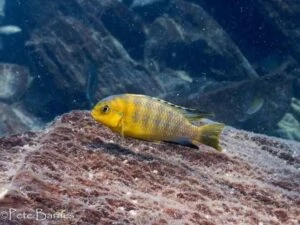Dimidiochromis strigatus
Dimidiochromis strigatus has no common name. The Scientific name can be broken up into several parts. “Di” means two and “Midio” means half. “Chromis” means fish. Roughly speaking, Dimidiochromis refers to the horizontal stripe that divides the fish in two. Strigatus is a reference to the vertical stripes on the flank of this species.
The genus Dimidiochromis includes only 4 species: strigatus, compressiceps, kiwinge and dimidiatus.
The species was first described by Regan in 1922. He also spawned two synonyms no longer used: Haplochromis strigatus and Cyrtocara strigatus.
Description
Dimidiochromis strigatus is one of the predators of Lake Malawi. The males can reach a length of about 25 centimeters. The females remain somewhat smaller at 20 centimeters.
The females are colored a dull grey/brown. A horizontal dark stripe runs along the flank. In adult males showing their breeding colors, this stripe can disappear completely. The line reappears when the man is not feeling well or under pressure.
The male, once mature, can turn blue. The scales show a red glow at the edges, which is most obvious just behind the gill cover. The base of the dorsal and anal fins often show a black border that ends in red towards the edge of the fin. Clear egg spots can be seen on the anal fin of the male, the females often have these less in number and less clearly marked.
The behavior of the Dimidiochromis strigatus can be described as fairly calm, although they are slightly more fanatical than the Dimidiochromis compressiceps. Usually, they hang quietly in the water waiting for prey. For this, they like to hang between some stems of Valisneria.
Biotope
The Dimidiochromis strigatus can be found throughout Lake Malawi, although you will not find them in large numbers anywhere. You can find them in fairly shallow sediment-rich waters with some vegetation. This is also the place where many species release their young because they can find enough food and some shelter here.
Diet
Young and small fish are food for the Dimidiochromis strigatus. Therefore, do not keep them together with young animals or species that are too small.
With their heads pointing downwards, it hangs motionless in the water. Preferably between some vegetation such as some shrubs or Valisneria. As soon as prey gets close enough, it strikes. With a lightning-fast lunge, it extends its mouth far and sucks in its prey.
In the aquarium, they actually accept all the food. To see the natural hunting behavior you could feed them with small fish. In any case, provide a varied diet that contains at least meaty food such as Krill, Artemia, Shrimp, Mussels, small fish, etc.
The Aquarium
Due to its size, Dimidiochromis strigatus needs a large aquarium. Think of an aquarium at least 200 centimeters long. On the bottom, use sand and a field with growing Valisneria such as Valisneria gigantae or Valisneria nana. Usually, Valisneria nana does better in a Malawi aquarium. As an alternative to the Valisneria you could also use long-winded Cryptos such as Cryptocoryne aponogetifolia.
The temperature and water values are fairly constant throughout the lake. Keep the temperature between 22 and 26 degrees Celsius. In the winter it is best to keep the temperature on the low side, in the summer it usually rises again.
Breeding aquarium and conditioning
No special breeding aquarium is required for the breeding of Dimidiochromis strigatus. Breeding will often succeed in an aquarium with different species.
Make sure that a male has access to 3 to 4 females. This way he spreads his attention over several females. If you only keep 1 female, the male can focus his full attention on her, which often leads to the loss of the female due to exhaustion.
The spawn
Before eggs are deposited, the male shows his best breeding colors. On a piece of sand chosen by him, he lures the female. Circling around each other, the female lays the eggs and immediately turns around and takes the eggs in her mouth. With the egg spot method, the man tricks the female. She bites at the egg spots on the anal fin of the male and in that way also ingests the sperm with which the eggs are fertilized.
After spawning, the female can clearly be seen incubating the eggs in her mouth. Her throat is clearly thicker and hangs down a bit. Sometimes it is even darker because you can see the fry through the skin of the throat.
Raising the fry
The young Dimidiochromis strigatus hatch after about 3 to 4 days. However, they remain in the female’s mouth for up to 3 weeks. After those three weeks, the female spits out the small fish.
You can feed the nest of fry with freshly hatched brine shrimp or simply with crushed flake food. They are not very sensitive to water changes. Clean water makes them grow faster.
You can just leave the female with the rest of the fish. In that case, the fry will be eaten by the other residents. Only the smartest and strongest youngsters have a chance to survive provided there are enough small hiding places.
If you really want to raise an entire nest, you can catch the female after a week or two and temporarily house her in a small aquarium without other inhabitants. You don’t have to feed her, she won’t eat with the boy in her mouth anyway. After spitting out the fry, she will not look at the fry for the first few hours. You can then calmly catch her and put her back in the regular aquarium.
Conclusion
With its slim body shape, Dimidiochromis strigatus is a specialized hunter. As long as you keep them with equally large and strong Malawi cichlids, this is a nice addition to your Malawi aquarium!
Video
Author
John de Lange
Copyright images
Wimmels.com
Marco van der Nol















Reviews
There are no reviews yet.